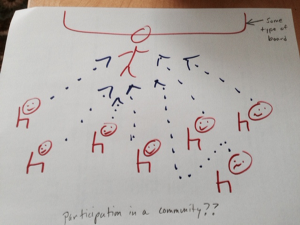
So what is participatory hospitality?
It’s certainly a mouthful. But beyond that, it is the result of merging the qualities of academic hospitality and guided participation. How can we expect our students to participate in our classrooms when they don’t feel comfortable doing so? Hospitality is centered in the relationship of self and others on matters of learning. The relationship between a student and their peers, and the relationship between the student and their professor. To encourage participation in the classroom, we must first create a safe environment for our students to do so. Being hospitable involves:
- Showing others that they are worthy of intellectual attention.
- Letting them know they matter as fellow inquiries.
- Working towards mutual interaction and reciprocity.

Participation is more than asking a question to your students and expecting them to know the answer. This approach can make students nervous, anxious, possibly even insecure about not knowing the “right answer”. Participation should be about creating a conversation.
“What if we asked students to tell us how they will participate? What if we asked them what they need from us? (120)”
In Michele Eodice’s chapter on “Participatory Hospitality and Writing Centers”, the author seeks to find a way to shift away from forced participation, and build a way toward interdependence. She proposes the concept of hospitality as a way of resisting individualism — which is a barrier to collaboration and community — and building interdependence. Interdependence is the dependence of two or more people on each other. In this context, Eodice encourages classroom learning to be done between peers, just as much as it is between instructor and students. 
This photo illustrates a poem written by Michele Eodice about how we participate with and as writers.
“Making learning environments more hospitable does not necessarily mean that we wait on our “guests” and they don’t have to lift a finger. How can we convey to students that they can make themselves at home in this space of learning—that if they want something, they can help themselves, but be sure to get enough to share with others and that they too have a role in helping to create and sustain the hospitality of the space? (35)”
Encouraging participatory hospitality rather than forced participation allows for writing teachers to position themselves as learners and design for a richer and more mutual conversation with students.
Some thoughts and questions moving forward:
- What are some ways we can help other academic spaces practice hospitality in a reciprocal way?
- How can cultural ideas about individuals and/or communities positively or negatively influence participatory hospitality in the writing center?
- The writing center is still sometimes perceived as an agent of the academy—to rule the writing of students for the convenience of instructors. How do we break through this and make a space for students to find a “sense of belonging” in order to write and develop ideas in whatever way they want or feel is more meaningful for them?
I encourage you all to check out this chapter on how to make your classroom a place where your students feel comfortable to participate! You can find a link to the chapter here.
